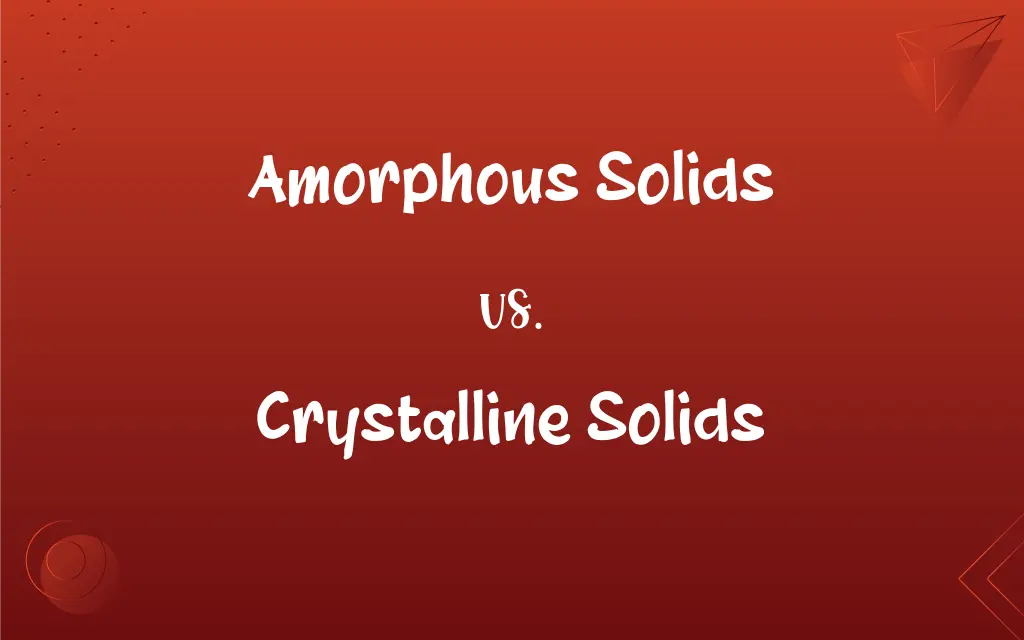Amorphous Solids vs. Crystalline Solids: What's the Difference?
Edited by Aimie Carlson || By Harlon Moss || Updated on October 13, 2023
Amorphous solids lack an ordered structure; crystalline solids have a defined, repeating pattern. Both are forms of solid matter with differing atomic arrangements.

Key Differences
Amorphous solids and crystalline solids differ primarily in their atomic or molecular arrangements. While amorphous solids have randomly arranged atoms or molecules, crystalline solids showcase a well-defined, repeating pattern throughout.
Both amorphous solids and crystalline solids can be found in everyday materials. Items like window glass and certain polymers exhibit the characteristics of amorphous solids. Conversely, salt and diamonds are examples of crystalline solids with their ordered structures.
When considering their properties, amorphous solids and crystalline solids can react differently to external stimuli. Amorphous solids tend to soften over a range of temperatures, whereas crystalline solids have a sharp melting point.
Amorphous solids and crystalline solids also exhibit variance in their optical properties. Amorphous substances often appear opaque or translucent due to their disordered arrangement. In contrast, many crystalline solids can be transparent as a result of their orderly lattice structure.
Lastly, in terms of their formation, amorphous solids typically form when a liquid cools too quickly for crystals to form. Crystalline solids, on the other hand, often develop as a result of slow cooling, allowing the orderly arrangement of their constituent particles.
ADVERTISEMENT
Comparison Chart
Atomic Arrangement
Randomly arranged
Ordered, repeating pattern
Melting Point
Softens over a range
Sharp, defined melting point
Optical Properties
Generally opaque or translucent
Often transparent
Formation Process
Quick cooling from liquid
Slow cooling allowing for orderly structure formation
Example
Window glass
Salt
ADVERTISEMENT
Amorphous Solids and Crystalline Solids Definitions
Amorphous Solids
Substances that lack a regular repeating pattern in their molecular arrangement.
Many polymers, when cooled rapidly, form amorphous solids.
Crystalline Solids
Materials with a highly ordered atomic structure.
Diamonds, with their intricate lattice structure, are crystalline solids.
Amorphous Solids
Materials that exhibit more of a gradual transition from the solid to the liquid state.
The rubber in some shoes is an example of amorphous solids that can become soft with heat.
Crystalline Solids
Substances that have a regular repeating pattern in their molecular arrangement.
Table salt, under a microscope, reveals its nature as a crystalline solid.
Amorphous Solids
Solids that don't have a crystalline lattice structure.
Cotton candy sugar, when melted and spun, behaves like amorphous solids.
Crystalline Solids
Substances that transition abruptly from solid to liquid state.
Pure metals, like gold, exhibit properties of crystalline solids when they melt.
Amorphous Solids
Materials with a disordered atomic structure.
The plastic used in some toys is an example of amorphous solids.
Crystalline Solids
Materials with sharp, defined melting points.
Ice, at 0°C, melts sharply, behaving as crystalline solids.
Amorphous Solids
Non-crystalline substances that soften over a range of temperatures.
Certain types of candy, when heated, become soft and moldable due to their amorphous solids nature.
Crystalline Solids
Solids with a defined lattice structure.
Many minerals found in nature, like quartz, are examples of crystalline solids.
FAQs
At what temperature do crystalline solids melt?
Crystalline solids have a sharp, specific melting point.
What are amorphous solids?
Amorphous solids have a random atomic or molecular arrangement without a regular repeating pattern.
Can you give an example of amorphous solids?
Yes, window glass is an example of amorphous solids.
What results in the formation of crystalline solids?
Slow cooling of a substance often leads to crystalline solids formation.
Name a common crystalline solid.
Salt is a commonly known crystalline solid.
Are amorphous solids transparent?
Amorphous solids are generally opaque or translucent due to their disordered structure.
Are all plastics amorphous solids?
No, while many plastics can be amorphous, some can also be semi-crystalline.
What’s the key difference between amorphous solids and crystalline solids?
The primary difference is their atomic or molecular arrangement; amorphous is random while crystalline is ordered.
Is glass a crystalline solid?
No, common glass is an example of an amorphous solid.
Are metals typically crystalline solids?
Yes, most metals are in their solid state.
Can a substance be both amorphous and crystalline?
Some materials can have both amorphous and crystalline regions, known as semi-crystalline materials.
How do amorphous solids respond to light?
Amorphous solids can be opaque or translucent, often scattering light due to their disordered arrangement.
Can amorphous solids be transformed into crystalline solids?
Yes, under certain conditions like heat and pressure, amorphous solids can become crystalline.
What defines crystalline solids?
Crystalline solids have a well-defined, ordered atomic or molecular structure.
Why are some crystalline solids clear?
The orderly arrangement in crystalline solids can allow light to pass through, making them transparent.
Are crystals always considered crystalline solids?
Yes, crystals, by definition, have a structured, repeating pattern, making them crystalline solids.
Do amorphous solids have a sharp melting point?
No, amorphous solids soften over a range of temperatures.
Can crystalline solids be transparent?
Yes, many crystalline solids, because of their ordered structure, can be transparent.
Do amorphous solids have a regular geometric shape?
No, amorphous solids lack a regular shape due to their disordered internal structure.
How are amorphous solids formed?
Amorphous solids typically form from rapid cooling of a liquid.
About Author
Written by
Harlon MossHarlon is a seasoned quality moderator and accomplished content writer for Difference Wiki. An alumnus of the prestigious University of California, he earned his degree in Computer Science. Leveraging his academic background, Harlon brings a meticulous and informed perspective to his work, ensuring content accuracy and excellence.
Edited by
Aimie CarlsonAimie Carlson, holding a master's degree in English literature, is a fervent English language enthusiast. She lends her writing talents to Difference Wiki, a prominent website that specializes in comparisons, offering readers insightful analyses that both captivate and inform.































































